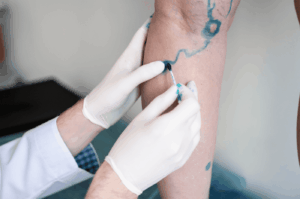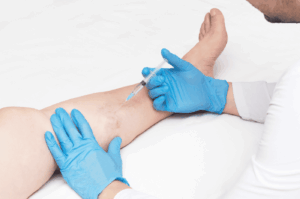| Compression therapy is a non-invasive treatment that uses targeted pressure to improve circulation and reduce pain. Commonly used for leg pain, swelling, and varicose veins, compression comes in various forms like stockings, sleeves, and bandages. By following an experienced vein specialist’s guidance and proper wear practices, compression therapy can significantly enhance your well-being. Are you ready to experience the benefits of compression therapy? Schedule an appointment with Miami Vein today for personalized guidance and effective vein solutions. |
Are you struggling with leg pain or swelling? You’re not alone! Many people experience these issues, and compression therapy can be a valuable tool for finding relief.
From choosing the right compression garments to maximizing their effectiveness, we’ll equip you with the knowledge you need to experience the positive impact of compression therapy.
Discover how compression therapy can help alleviate pain and promote vein health in this blog post.
What Is Compression Therapy And How Does It Work?
Compression therapy is a non-invasive treatment that involves applying pressure to specific areas of the body to improve circulation and reduce pain. It works by squeezing the affected area, which helps to increase blood flow and reduce swelling.
There are different types of compression therapy, including static compression and dynamic compression. Static compression involves applying constant pressure to the affected area, while dynamic compression involves applying intermittent pressure.
Compression therapy is commonly used to treat conditions such as venous insufficiency, lymphedema, and deep vein thrombosis. It can also be beneficial for individuals who experience pain and swelling in their legs or arms.
The pressure applied during compression therapy helps to improve the flow of blood and lymphatic fluid, which can reduce pain and promote healing. It can also help to prevent blood clots and reduce the risk of complications.
Compression therapy can be performed using compression garments, such as sleeves, stockings, or bandages. These garments are available in different levels of compression, which are measured in millimeters of mercury (mmHg). The appropriate level of compression depends on the specific condition being treated and should be determined by a healthcare professional.
Overall, compression therapy is a safe and effective treatment option for pain management and vein health. It can provide relief from pain, reduce swelling, and improve circulation, leading to enhanced overall well-being.
Types Of Compression Therapy
Several types of compression therapy can be used to alleviate pain and promote vein health. Each type performs a specialized function and which type or combination of types is right for you will be assessed and determined by your healthcare professional.
These include:
- Compression stockings: These are specially designed stockings that apply pressure to the legs or arms to improve blood flow. They are commonly used to treat conditions such as varicose veins, edema, and venous ulcers.
- Compression sleeves: These are similar to compression stockings but are designed to be worn on the arms. They can be beneficial for individuals who experience swelling or pain in their arms, such as those with lymphedema or post-mastectomy.
- Compression bandages: These are elastic bandages that can be wrapped around the affected area to provide compression. They are often used to treat acute injuries, such as sprains or strains.
The type of compression therapy that is most appropriate will depend on the specific condition being treated and should be determined by a healthcare professional. It is important to follow the recommended guidelines for wearing and caring for compression garments to ensure maximum effectiveness.
It is also worth noting that there are different levels of compression available, ranging from mild to firm. The appropriate level of compression will depend on the severity of the condition and should be determined by a healthcare professional.
Choosing the Right Compression Garments
When you’re choosing compression garments, it is important to consider your specific needs and the condition being treated. Not all garments are created equal! Some are designed for specific areas of the body, while others offer varying levels of compression.
To ensure optimal effectiveness and comfort, let’s explore the different types of compression garments available. Here are some factors to consider:
- Compression level: The appropriate level of compression will depend on the severity of the condition and should be determined by a healthcare professional.
- Size and fit: Compression garments should fit snugly but not be too tight. It is important to measure the affected area accurately and choose the correct size.
- Material: Compression garments are typically made from a blend of materials, such as nylon, spandex, or cotton. It is important to choose a material that is comfortable and breathable.
- Style: Compression garments are available in various styles, including stockings, sleeves, and bandages. The choice of style will depend on the specific needs of the individual and the affected area.
It is recommended to consult with a healthcare professional or compression therapy specialist when choosing compression garments to ensure the best fit and effectiveness.
Benefits of Compression Therapy for Pain Management
Compression therapy has become a popular choice for pain management due to its effectiveness and wide range of benefits. Let’s delve into the scientific side of things to understand how compression therapy targets pain at its source and promotes healing within the body.
Compression therapy offers several benefits for pain management, including:
- Pain relief: The pressure applied during compression therapy can help to alleviate pain by improving circulation and reducing inflammation.
- Reduced swelling: Compression therapy can help to reduce swelling in the affected area by promoting the flow of lymphatic fluid and preventing fluid buildup.
- Improved circulation: By squeezing the affected area, compression therapy helps to improve blood flow, which can enhance overall circulation and promote healing.
- Prevention of blood clots: Compression therapy can help to prevent blood clots by improving blood flow and reducing the risk of stasis.
- Enhanced overall well-being: By reducing pain and swelling, compression therapy can improve quality of life and overall well-being.
It is important to note that compression therapy should be used as part of a comprehensive pain management plan and under the guidance of a healthcare professional.
Tips for Using Compression Therapy Effectively
Working closely with your healthcare professional ensures you receive the right level of compression and wear garments for the appropriate amount of time to address your specific needs.
While they will share a list of recommendations for you, there are a few general things you can do to prolong and maximize your results. To maximize the effectiveness of compression therapy, consider the following tips:
- Follow the recommendations of a healthcare professional regarding the appropriate level of compression and duration of use.
- Wear compression garments as instructed, ensuring they are properly fitted and comfortable.
- Take breaks from wearing compression garments if recommended by a healthcare professional.
- Keep the affected area clean and dry to prevent skin irritation or infection.
- Regularly inspect compression garments for signs of wear and tear, and replace them as needed.
By following these tips, individuals can optimize the benefits of compression therapy and promote pain relief and vein health.
Ready to Experience the Pain Relief and Improved Vein Health that Compression Therapy can Offer?
At Miami Vein, we’re dedicated to helping you find the right solution for your needs. Our team of experts will work with you to determine the appropriate level of compression and recommend garments that ensure optimal comfort and effectiveness.
We offer a wide range of compression options to suit your lifestyle, and we’ll guide proper wear and care. Don’t wait any longer to take control of your leg health.
Schedule an appointment with Miami Vein today and experience the difference compression therapy can make in your life!
Frequently Asked Questions
1. How long should I wear compression garments?
The duration of compression garment wear will depend on the specific condition being treated and should be determined by a healthcare professional. In some cases, compression garments may need to be worn all day, while in others, they may only need to be worn during certain activities.
2. Are compression garments uncomfortable to wear?
Compression garments may feel tight at first, but they should not be uncomfortable or painful. It may take some time to get used to wearing them, but they should not cause significant discomfort. If discomfort persists, it is important to consult with a healthcare professional.
3. Can compression therapy be used during pregnancy?
Compression therapy can be beneficial during pregnancy to help reduce swelling and discomfort in the legs. However, it is important to consult with a healthcare professional before using compression therapy during pregnancy to ensure it is safe and appropriate.
4. Can I wash compression garments?
Yes, compression garments can usually be washed. It is important to follow the manufacturer’s instructions for washing and caring for the garments to ensure their longevity and effectiveness.
5. Can anyone use compression therapy?
Compression therapy is generally safe for most individuals. However, it is important to consult with a healthcare professional before starting compression therapy, especially if you have any underlying medical conditions or concerns.
These are just a few frequently asked questions about compression therapy. If you have any specific questions or concerns, it is always best to consult with a healthcare professional or compression therapy specialist.


